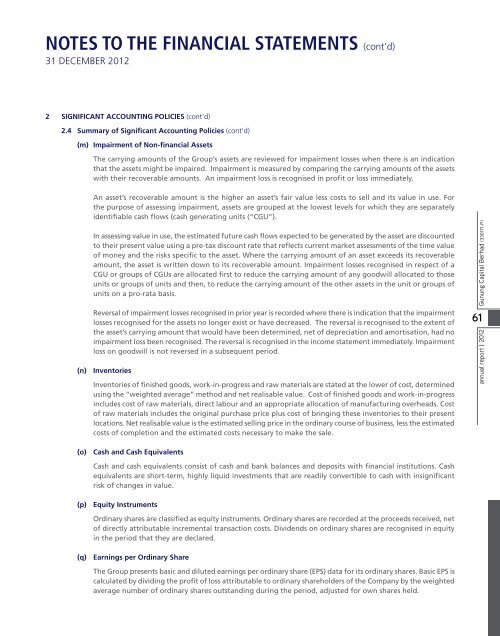Download PDF - ChartNexus
Download PDF - ChartNexus
Download PDF - ChartNexus
You also want an ePaper? Increase the reach of your titles
YUMPU automatically turns print PDFs into web optimized ePapers that Google loves.
NOTES TO THE FINANCIAL STATEMENTS (cont’d)<br />
31 DECEMBER 2012<br />
2 SIGNIFICANT ACCOUNTING POLICIES (cont’d)<br />
2.4 Summary of Significant Accounting Policies (cont’d)<br />
(m) Impairment of Non-financial Assets<br />
The carrying amounts of the Group’s assets are reviewed for impairment losses when there is an indication<br />
that the assets might be impaired. Impairment is measured by comparing the carrying amounts of the assets<br />
with their recoverable amounts. An impairment loss is recognised in profit or loss immediately.<br />
An asset’s recoverable amount is the higher an asset’s fair value less costs to sell and its value in use. For<br />
the purpose of assessing impairment, assets are grouped at the lowest levels for which they are separately<br />
identifiable cash flows (cash generating units (“CGU”).<br />
In assessing value in use, the estimated future cash flows expected to be generated by the asset are discounted<br />
to their present value using a pre-tax discount rate that reflects current market assessments of the time value<br />
of money and the risks specific to the asset. Where the carrying amount of an asset exceeds its recoverable<br />
amount, the asset is written down to its recoverable amount. Impairment losses recognised in respect of a<br />
CGU or groups of CGUs are allocated first to reduce the carrying amount of any goodwill allocated to those<br />
units or groups of units and then, to reduce the carrying amount of the other assets in the unit or groups of<br />
units on a pro-rata basis.<br />
Reversal of impairment losses recognised in prior year is recorded where there is indication that the impairment<br />
losses recognised for the assets no longer exist or have decreased. The reversal is recognised to the extent of<br />
the asset’s carrying amount that would have been determined, net of depreciation and amortisation, had no<br />
impairment loss been recognised. The reversal is recognised in the income statement immediately. Impairment<br />
loss on goodwill is not reversed in a subsequent period.<br />
(n) Inventories<br />
Inventories of finished goods, work-in-progress and raw materials are stated at the lower of cost, determined<br />
using the “weighted average” method and net realisable value. Cost of finished goods and work-in-progress<br />
includes cost of raw materials, direct labour and an appropriate allocation of manufacturing overheads. Cost<br />
of raw materials includes the original purchase price plus cost of bringing these inventories to their present<br />
locations. Net realisable value is the estimated selling price in the ordinary course of business, less the estimated<br />
costs of completion and the estimated costs necessary to make the sale.<br />
(o) Cash and Cash Equivalents<br />
Cash and cash equivalents consist of cash and bank balances and deposits with financial institutions. Cash<br />
equivalents are short-term, highly liquid investments that are readily convertible to cash with insignificant<br />
risk of changes in value.<br />
(p) Equity Instruments<br />
Ordinary shares are classified as equity instruments. Ordinary shares are recorded at the proceeds received, net<br />
of directly attributable incremental transaction costs. Dividends on ordinary shares are recognised in equity<br />
in the period that they are declared.<br />
(q) Earnings per Ordinary Share<br />
The Group presents basic and diluted earnings per ordinary share (EPS) data for its ordinary shares. Basic EPS is<br />
calculated by dividing the profit of loss attributable to ordinary shareholders of the Company by the weighted<br />
average number of ordinary shares outstanding during the period, adjusted for own shares held.<br />
Gunung Capital Berhad (330171-P)<br />
61<br />
annual report | 2012

















